Priscilla's
Bird Photography
Photos from personal trips AND trips with
Birds of Oregon and General Science, (BOGS)
in association with Eugene's Celeste Campbell Center
Priscilla Sokolowski
Eugene, OR



BOGS Fern Ridge Reservoir, Royal Ave & Perkins Peninsula,
Jan 8, 2015; Trip Report
We began 2015 with a bird walk rather than a registration meeting, because the first Thursday in January was New Year's Day, so of course we had no meeting of any kind. So it was the 8th of January before BOGS got together, and being the 2nd Thursday of the month, we began the term with a bird walk.
It was a foggy morning, so I was surprised to see about as many as a dozen members at the Campbell Center when I arrived shortly before 9am. Doris had mailed out an announcement that our walk would be at Fern Ridge Reservoir on Royal Ave, and I knew from previous times that quite a few of our members live out that way and meet us at the parking area rather than driving into town to the Campbell Center. We could expect our group to nearly double in size when we got to Fern Ridge.
BOGS had missed some bird walks in December for various reasons. Twice the Walterville trip was cancelled due to bad weather ;once for nearly freezing road conditions and once because of a high wind alert. The Winter break always seems long to me anyway, and maybe to others as well. It having been such a long time since most of us had seen each other, people were pretty talkative. Steve had to ask for quiet so he could give instructions.
The plan was to bird the Royal Ave area and then head to Perkins Peninsula Park, where we had hopes of getting a glimpse of the SNOWY OWL which has been out in the mud flats since mid-December. Finally we gathered into car-pool groups and got going.
Once we arrived at Fern Ridge, I would estimate we had about twenty people. Still, this is smaller than the size of group we had most of Fall Tern. Again, the group was very talkative. Steve suggested that as a smaller than usual group, we could try to be more quiet and perhaps see more birds. I don't mean to suggest he was scolding us. It wasn't like that. It was a good idea, and there were times during the bird walk when we were in fact pretty quiet.
The fog made birding more challenging, as you can well imagine. We dealt with quite a few nearly colorless dark shapes in rather dim light. Raptors especially tended to be at some distance. I remember joking that someone should write a field guide showing birds the way we were seeing them; some photos showing what the bird really looks like, and then some photos showing what you are more likely to see. Oh, it wasn't that bad, really. Actually some birds presented themselves close enough to see quite clearly. Twice we saw Downy Woodpeckers in bushes only a short distance away, where everyone got a good look at them. There was a Northern Flicker near the beginning of the walk too, but it was further out and because of the fog, we identified it only after some of its field marks were faintly seen.
In the photo below you can see the bill of the Woodpecker is not longer than the diameter of the head. That is a good field mark, making it a Downy rather than a Hairy Wood pecker.

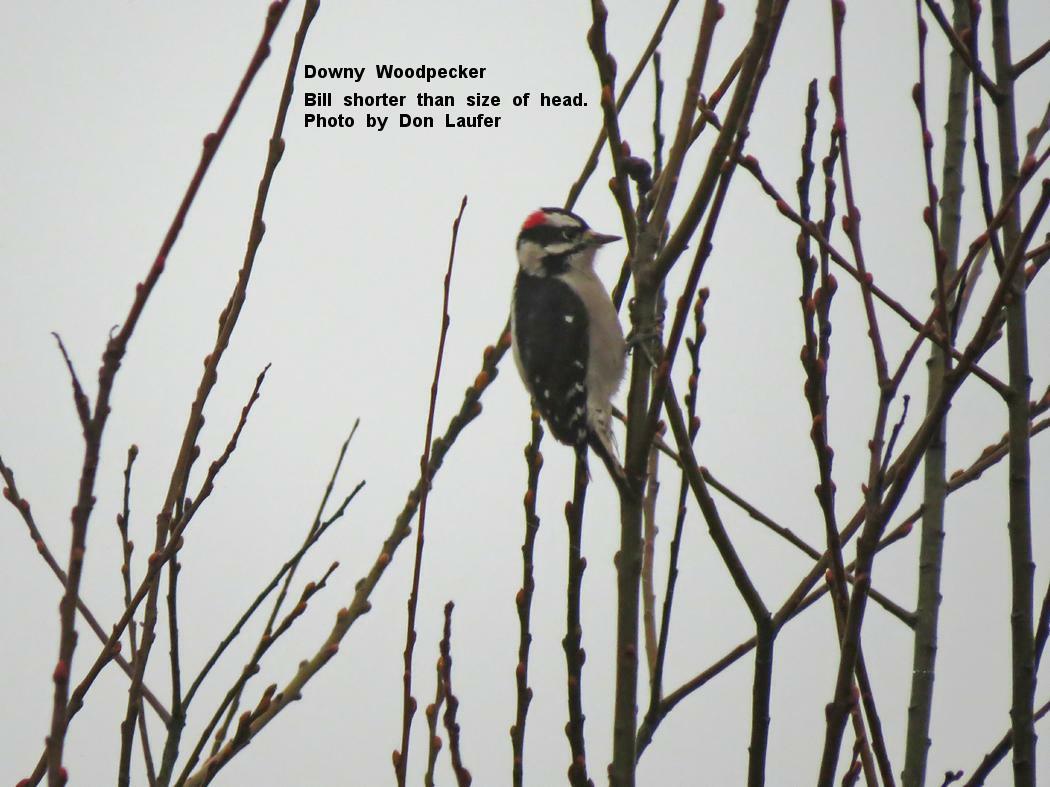
Some birds were only heard and not seen. Some Marsh Wrens were singing for example, and several times Geese flew very low over our heads, cackling or honking, depending on the subspecies.
Somehow, we succeeded in identifying a Red-Shouldered Hawk perched on a post near where the trail turns to go to the observation platform. This was pretty tricky, at least I thought so, until it flew. I don't know what people saw while it was still perched, maybe it was the white stripes on the tail, which are wider than on a Red-Tailed Hawk.

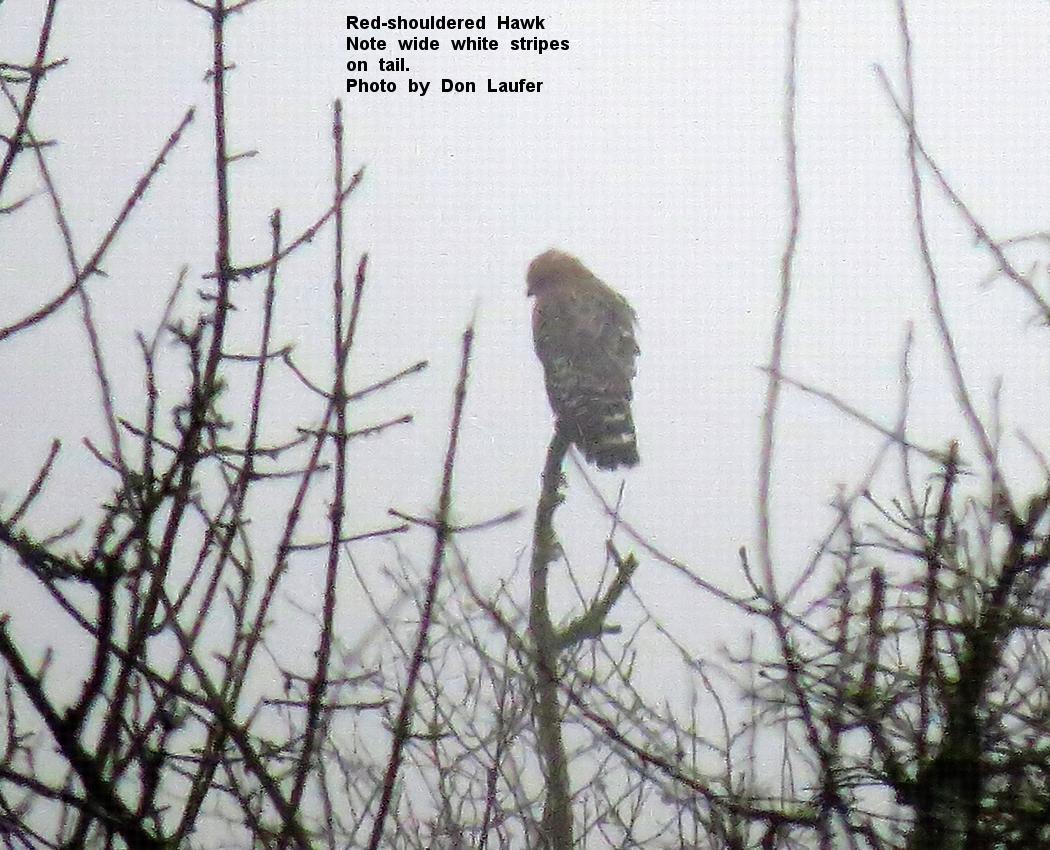
I didn't see those wide white stripes until I snapped a photo while after it began to fly. But don't think I planned it that way. By the time I got my camera focused on the bird and pressed the shutter, it was already on the wing. But that turned out to be a good thing.

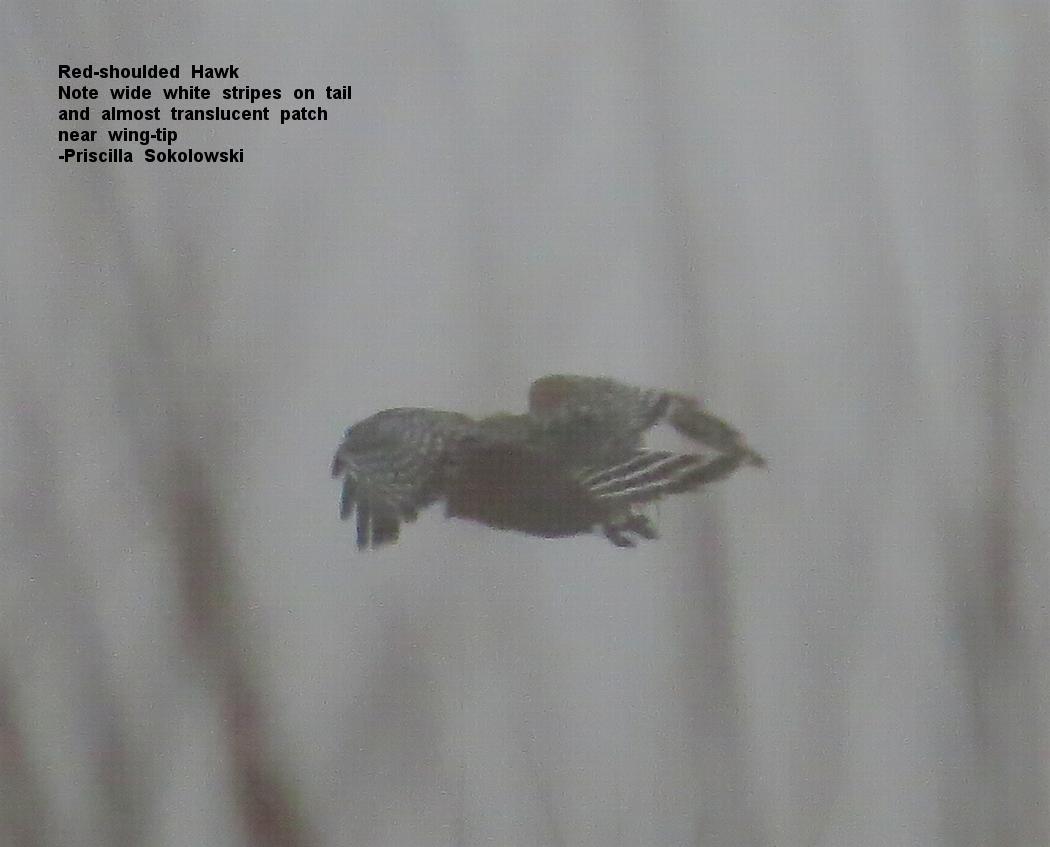
The pond right where the trail turns south to go to the platform had a pair of ducks. The fog tricked some members into thinking this was a female duck of some species, but after more people zeroed in on it, the faint green patch near the eye was detected and it was found to be a male Green-winged Teal. You can see in this photo, that even after brightening the image afterwards, the fog definitely robbed our birds of a lot of color!

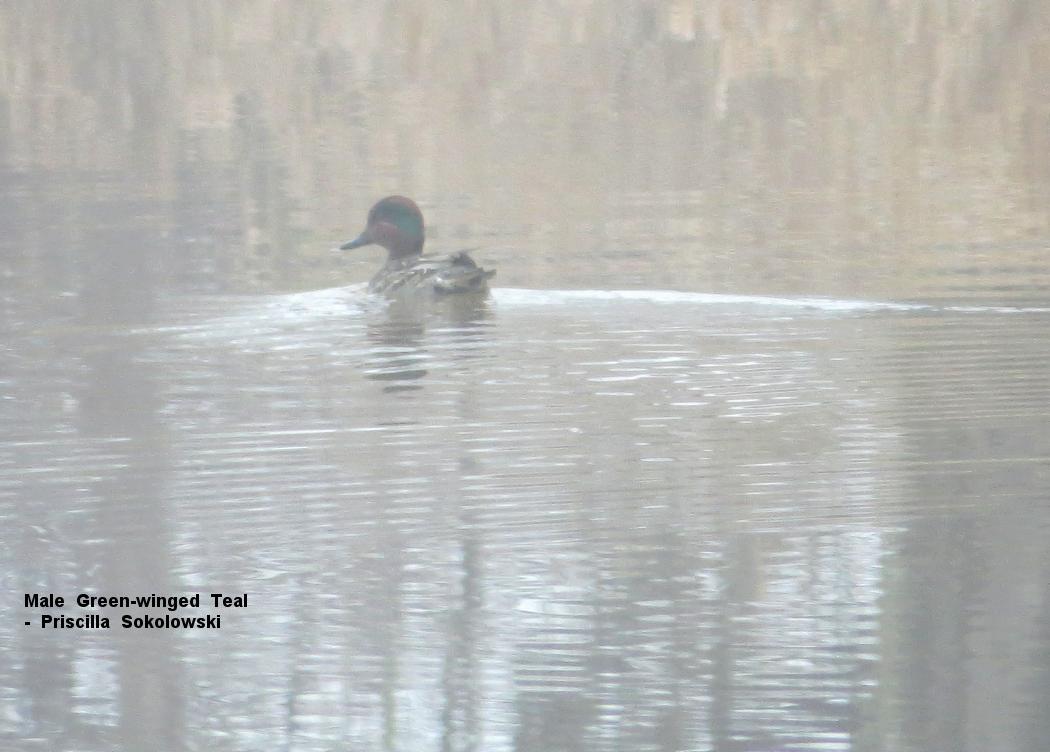
We looked around from the observation platform for quite a while and folks were having a good time chatting and spotting a few birds here and there. Don got pretty close to a Downy Woodpecker. Janet noticed something moving around low in the bushes. That turned out to be an American Coot, once it came out in the open where we could see it. Killdeer were heard flying nearby. So were Cackling and Canada Geese when they flew over. This was probably where the Bufflehead on Doris's list was seen.
After we drove away from the Royal Ave parking lot, we stopped at the Acorn Woodpecker patch for a few minutes. Those in the first few cars saw a Cooper's Hawk in the trees no far from the road. Although the Hawk took flight and went further back into the stand of trees, its presence apparently left the Acorn Woodpeckers very wary. There were very quiet and inactive. I think one or two were seen or heard by a few people, but most of us didn't have any luck.
We arrived at Perkins Peninsula and walked to the far northern end of the point. Ravens are one of the most conspicuous birds at this park. Without much effort, we saw Dark-eyed juncos, Varied thrush, and American robins. I got a little behind somehow, so I missed some of the action, but I think it was along this stretch where our group most likely encountered most of the following birds: Black-capped chickadee, Spotted towhee, Song sparrow, Golden-crowned sparrow, European starling, Red-winged blackbird (heard), and Brewer's blackbird. Come to think about it, the Red-winged blackbird might have been heard back at the observation platform off Royal.
At the farthest north point of land there is a stairway going down to the old paved trail which winds most of the way along the peninsula near the water's edge (when the reservoir is full). From there we looked for the Snowy Owl, but there was just a little too much fog to get even a glimpse of it.
As we walked the shoreline path, a Fox sparrow was seen raking the ground the way Towhees do it. I've only knowingly seen a Fox Sparrow one time before this, less than a month ago on Dec. 14, at the Oakridge Christmas Bird Count. I've yet to identify one on my own, but this sighting prepared me for being able to do that. This sparrow is a very uniformly dark chocolate brown above. On its light colored breast it is densely marked with fairly large inverted "V" shaped brown chevrons. I enjoyed seeing this Fox Sparrow up close.

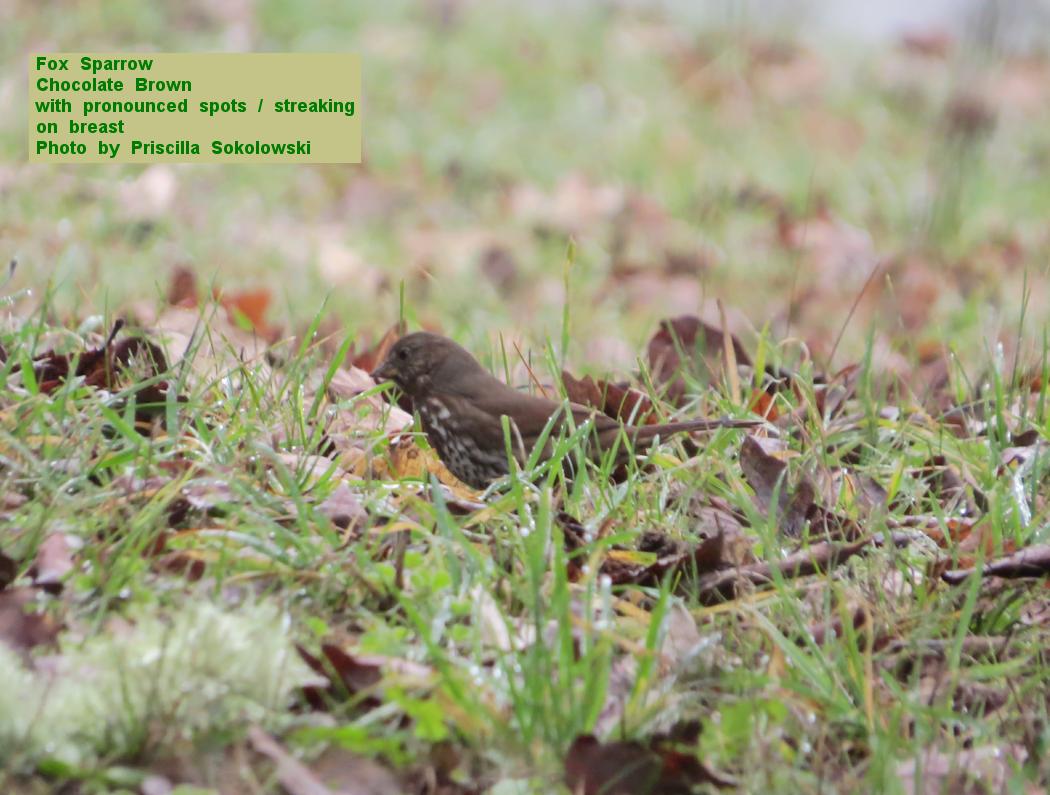
Flocks of Robins were seen in the grassy fields to the side of the main road as we walked back towards the parking area near West 11th. There was a mixed flock of birds on the ground having at least four species: Varied Thrush, American Robins, European Starlings and a Northern Flicker.

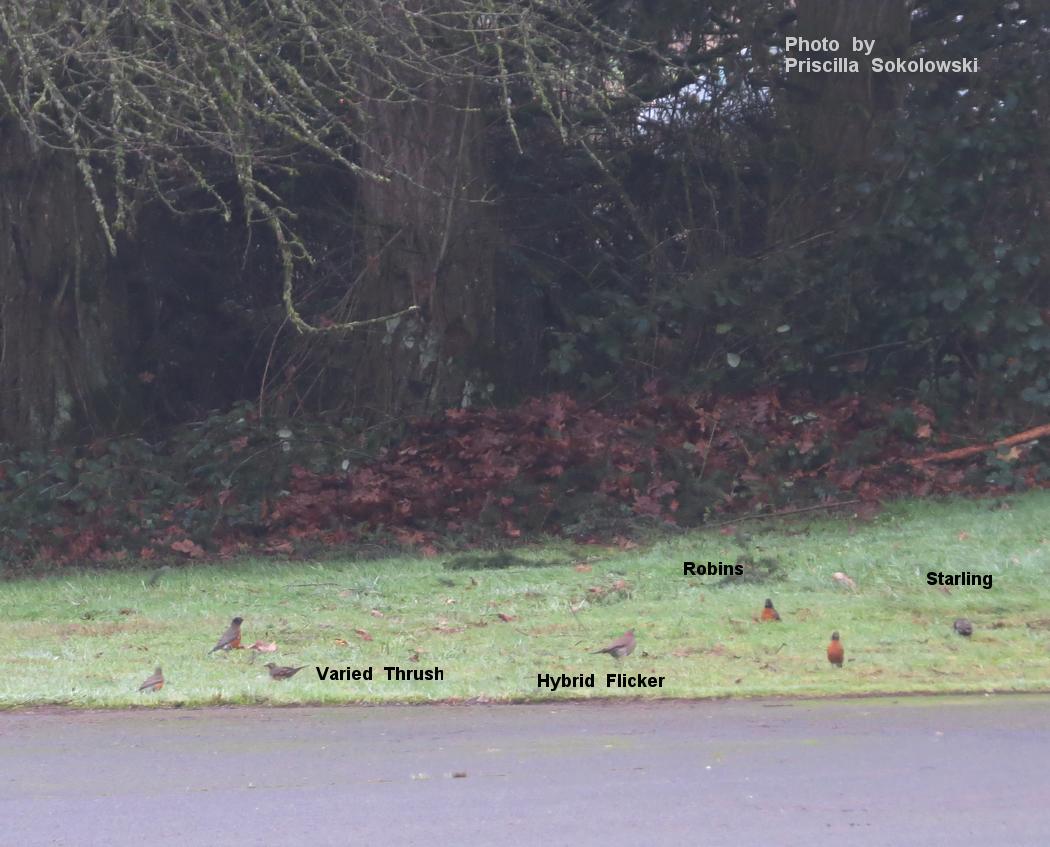
The "finale" of our trip came when we noticed the red crescent on the nape of the Northern Flicker. The Red-shafted race of Norther Flickers which are the predominant form west of the Rocky Mtns does not have this red on the nape of the neck; however, the eastern race, the Yellow-shafted Flicker, does have the red crescent on the back of the neck.
So was this bird a Yellow-shafted Flicker? As it turns out, no, it wasn't. This bird also had a red malar (tear-drop shaped mustache), which is not found on Yellow-shafted Flickers. So what we had is called an "intergrade" form. The two races are not considered separate species and they do inter-breed. From what I understand, the intergrade form we waw is not too uncommon.

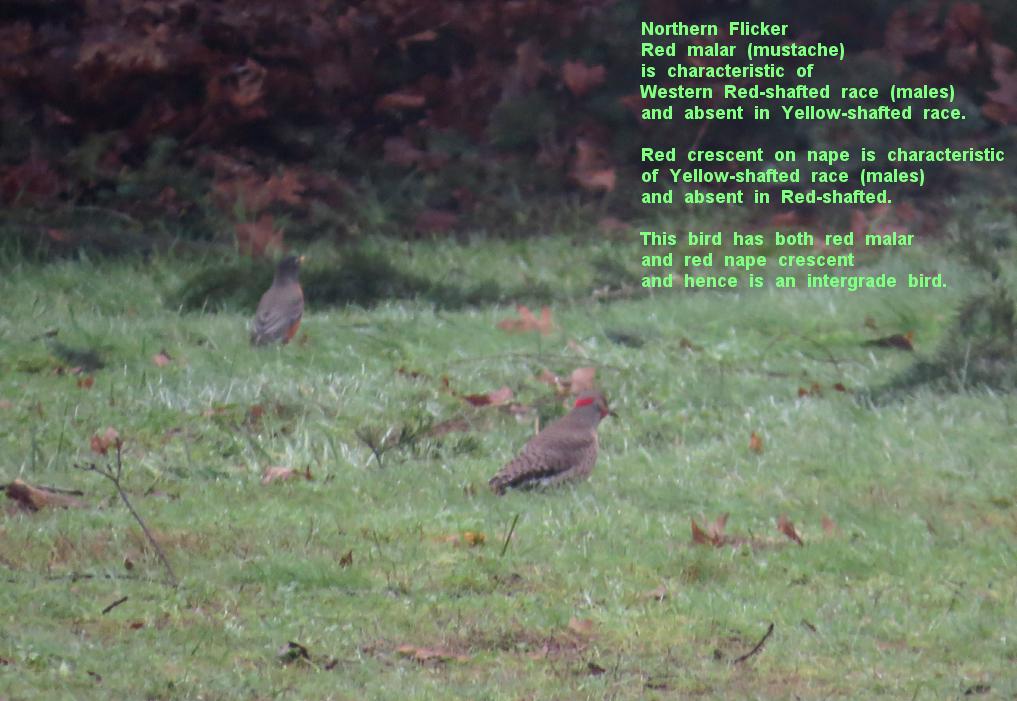

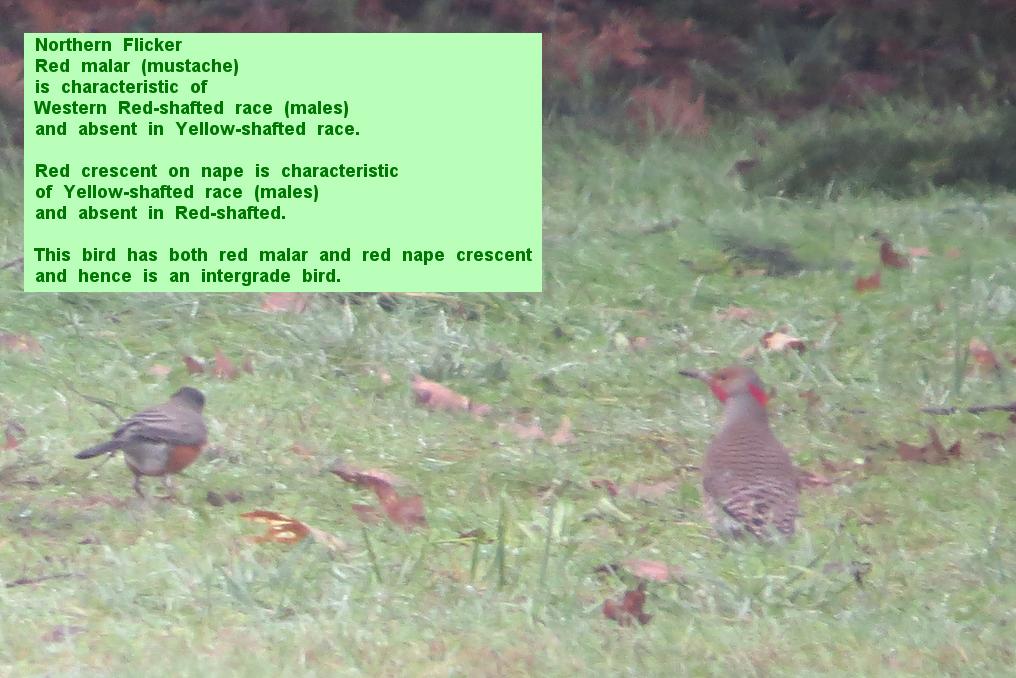
Bird list for January 8, 2015, for walk at Fern Ridge Reservoir, the end of Royal Ave., the "Acorn Woodpecker woods", and Perkins Peninsula.
The weather was foggy, with visibility fading at around 100 ft, and cold temperatures.
--- compiled by Doris Wimber
- Double- crested cormorant
- Great blue heron
- Cackling goose
- Canada goose
- Green-winged teal
- Bufflehead
- Red-shouldered hawk
- Red-tailed hawk
- Cooper's Hawk
- American kestrel
- American coot
- Killdeer (heard)
- Gull
- Rock pigeon
- Dove (Mourning or Euro. collared dove?)
- Acorn woodpecker
- Northern flicker (Intergrade)
- Red-breasted sapsucker
- Downy woodpecker
- Hairy woodpecker
- American crow
- Raven
- Black-capped chickadee
- Marsh wren
- Golden-crowned kinglet
- Ruby-crowned kinglet
- Varied thrush
- American robin
- Spotted towhee
- Song sparrow
- Golden-crowned sparrow
- Fox sparrow
- Dark-eyed junco
- European starling
- Red-winged blackbird (heard)
- Brewer's blackbird
The photo slide-show for this trip can be found here:
http://priscillanhk.com/bogs-fern-ridge-royal-1-8-15.html
Generally if you want to know what is happening next at BOGS, or want to see the latest photos/reports,
you can find these on my "updates" page:
http://priscillanhk.com/updates.html
Enjoy!
Priscilla